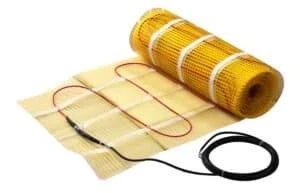In the quest for sustainable living, homeowners are increasingly turning to innovative solutions to reduce their carbon footprint while enhancing comfort and efficiency in their homes. Among these solutions, underfloor heating mats have emerged as a game-changer, offering a green alternative to traditional heating systems. In this blog, we\'ll explore how underfloor heating mats contribute to eco-friendly living, providing sustainable heating solutions for modern homes.
Sustainable Heating: The Need of the Hour
With growing concerns about climate change and environmental degradation, the need to adopt sustainable practices in every aspect of life has become imperative. Heating accounts for a significant portion of energy consumption in homes, contributing to greenhouse gas emissions and environmental pollution. Traditional heating systems, such as forced-air furnaces and radiators, often rely on fossil fuels like natural gas or oil, exacerbating the environmental impact.
Floor Heating Mats: A Greener Alternative
Underfloor heating mats offer a sustainable alternative to conventional heating methods by harnessing the principles of radiant heating. These mats consist of electric heating cables encased in a thin, flexible material that can be installed directly beneath the floor covering, such as tiles, laminate, or engineered wood. Unlike traditional heating systems that rely on air circulation to distribute heat, underfloor heating mats emit radiant heat from the floor surface, creating a comfortable and consistent warmth throughout the room.
Advantages:
- Energy Efficiency: Floor heating mats operate at lower temperatures compared to traditional heating systems, resulting in reduced energy consumption. By heating the floor surface directly, they minimize heat loss and heat the living space more efficiently, leading to lower energy bills and decreased carbon emissions.
- Renewable Energy Integration: Underfloor heating mats are compatible with renewable energy sources such as solar power. By coupling them with solar panels or other renewable energy systems, homeowners can further reduce their reliance on fossil fuels and contribute to a cleaner, more sustainable energy ecosystem.
- Zoned Heating: Floor heating mats allow for zoned heating, meaning that homeowners can control the temperature of individual rooms or zones independently. This precise temperature control not only enhances comfort but also reduces energy wastage by heating only the areas that are in use.
- Longevity and Durability: Underfloor heating mats are designed for longevity, with many manufacturers offering warranties of up to 25 years or more. Their durable construction and minimal maintenance requirements ensure that they remain a sustainable heating solution for the long term, reducing the need for frequent replacements and associated environmental impact.
- Comfort and Indoor Air Quality: By eliminating the need for bulky radiators or forced-air vents, electric underfloor heating free up valuable space and promotes better indoor air quality. Without the circulation of dust and allergens associated with traditional heating systems, occupants can enjoy a healthier and more comfortable living environment.
Installation Considerations:
- Installing electric underfloor heating is a crucial process that requires careful planning and execution to ensure optimal performance and longevity. While these heating solutions offer numerous advantages for sustainability, achieving the full potential of underfloor heating mats hinges on proper installation practices.
- First and foremost, it\'s essential to recognize that underfloor heating mats are not a one-size-fits-all solution. Each home presents unique characteristics, such as its layout, size, insulation, and flooring type, which can influence the effectiveness of underfloor heating systems. Therefore, consulting with a qualified heating contractor or installer is highly recommended. These professionals possess the expertise to assess your home\'s suitability for underfloor heating and recommend the most suitable system based on your specific needs, preferences, and budget.
- During the consultation phase, the installer will conduct a thorough assessment of your home\'s infrastructure to determine the feasibility of underfloor heating. Factors such as the construction of the subfloor, existing heating systems, and insulation levels will be taken into account. Additionally, the installer will consider your desired heating preferences, such as the desired temperature levels, zoning requirements, and control options.
- Once the suitability of underfloor heating mats is established, the installation process begins. This involves careful planning and precision to ensure that the heating mats are laid out evenly and securely across the designated areas. The positioning and spacing of the heating elements must be calculated accurately to achieve uniform heat distribution without any cold spots or overheating issues.
- Special attention should also be paid to the type of flooring material being installed over the heating mats. Different flooring materials conduct heat differently, and some may require additional insulation or underlayment to optimize heat transfer and efficiency.
- Throughout the installation process, it\'s crucial to adhere to industry best practices and manufacturer guidelines to avoid damaging the heating elements and compromising the system\'s performance. Any mistakes or shortcuts during installation can lead to inefficient heating, increased energy consumption, and potential safety hazards.
Furthermore, homeowners should be aware of any local building codes, regulations, or permits required for underfloor heating installations. Compliance with these regulations ensures the safety and legality of the installation while protecting homeowners from potential liabilities.
In conclusion, underfloor heating mats represent a sustainable heating solution for modern homes, offering energy-efficient operation, compatibility with renewable energy sources, and enhanced comfort and indoor air quality. By embracing this green technology, homeowners can reduce their environmental footprint while enjoying the warmth and comfort of a truly sustainable heating system.


